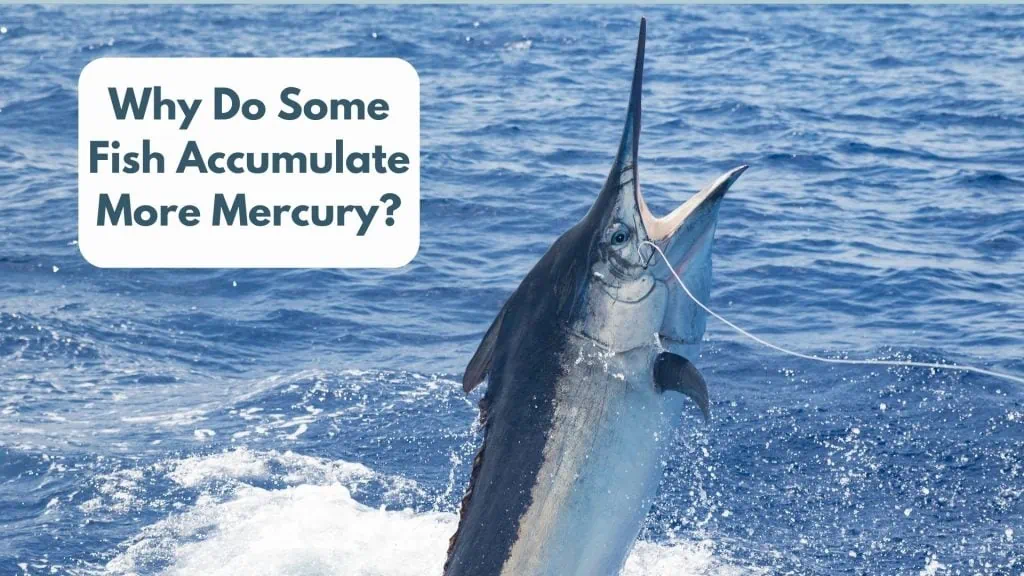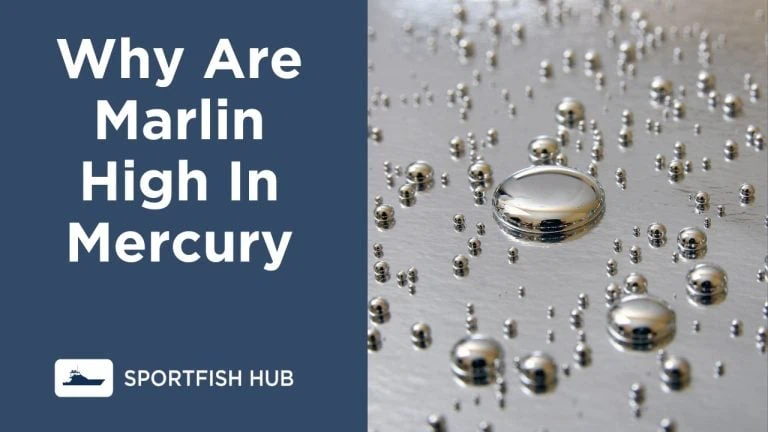Marlin and other large predatory fish tend to have higher levels of mercury. Understanding why marlin contain more mercury can help you make informed seafood choices if you need to know about mercury in fish and shellfish.
- Mercury Levels Vary in Different Fish
- Why Do Some Fish Accumulate More Mercury?
- Health Risks of Mercury in Fish
- Tips for Avoiding Excess Mercury from Fish
- Reducing Mercury Emissions
- Summary
- Frequently Asked Questions:
- Q: Are all types of marlin high in mercury?
- Q: How can I reduce my risk from mercury when eating fish and shellfish?
- Q: How does the amount of fish I eat impact mercury levels in my body?
- Q: Are there fish that are low in mercury?
- Q: Where does the mercury in fish come from?
- Q: What’s the difference between the mercury in fish and mercury poisoning?
- Sources:
Mercury Levels Vary in Different Fish
The amount of mercury in fish depends on the species, size, diet and environmental factors. Larger and longer-lived fish generally have higher mercury levels because they’ve had more time to accumulate mercury through mercury exposure while eating other fish.
Marlin, swordfish, shark, tilefish, king mackerel and bigeye tuna are among the fish that tend to have the highest mercury levels. Meanwhile, fish like salmon, shrimp and tilapia have very low mercury levels.
Here are some typical mercury concentrations in popular seafood:
| Seafood | Mercury Concentration (ppm) |
|---|---|
| Marlin | 0.485 |
| Swordfish | 0.995 |
| Shark | 0.979 |
| King Mackerel | 0.730 |
| Bigeye Tuna | 0.689 |
| Tilefish (Gulf of Mexico) | 0.654 |
| Orange Roughy | 0.571 |
| Fresh Tuna | 0.389 |
| Grouper | 0.268 |
| Chilean Sea Bass | 0.255 |
| Halibut | 0.241 |
| Lobster | 0.107 |
| Mahi Mahi | 0.076 |
| Pollock | 0.031 |
| Cod | 0.111 |
| Salmon | 0.022 |
| Tilapia | 0.013 |
| Shrimp | 0.001 |
The FDA recommends keeping blood mercury under 5 mcg/L. Eating fish high in mercury can cause you to exceed this limit.

Why Do Some Fish Accumulate More Mercury?
Mercury occurs naturally, but pollution from coal burning and other industrial processes increase mercury in the environment.
Once in water, mercury is converted to methylmercury, its more toxic organic form. Methylmercury is absorbed by tiny aquatic organisms like plankton.
Small fish eat the plankton and larger fish eat the smaller fish. At each step in the food chain, the mercury concentration increases through bioaccumulation.
That’s why large predatory fish like marlin and swordfish tend to contain the highest mercury levels. They’ve lived longer and eaten many smaller fish, accumulating mercury over time.
Health Risks of Mercury in Fish
Consuming high levels of mercury from fish can cause serious health problems like mercury poisoning. Mercury is a neurotoxin that impairs brain and central nervous system function.
Some potential effects of mercury toxicity include:
- Impaired cognitive skills and memory
- Difficulty balancing and coordinating
- Numbness or tingling
- Impaired vision and hearing
- Muscle weakness
Mercury exposure has also been linked to increased risk of heart disease. Sensitive groups like pregnant women and young children face the greatest risks from mercury exposure in humans.
However, for most people the benefits of eating fish outweigh potential mercury risks. Fish provide important nutrients like omega-3s, vitamin D, selenium and protein.
Tips for Avoiding Excess Mercury from Fish
You don’t need to avoid fish altogether. Just be smart about your choices:
- Eat a variety of fish and shellfish, rather than the same types every week. This helps reduce exposure.
- Limit high-mercury fish like marlin, swordfish and shark.
- Enjoy low-mercury choices like salmon, shrimp, pollock and tilapia.
- Check local advisories about mercury levels in fish caught from local lakes and rivers.
- Split consumption between low and high mercury levels when eating tuna. Choose light tuna more often.
- Pregnant women should follow guidelines for limiting mercury exposure from fish.
Reducing Mercury Emissions
Supporting policies and technologies to reduce mercury emissions from power plants and industrial sources can help lower mercury levels in fish over time.
Summary
Overall, a balanced seafood diet following basic mercury precautions can offer great health benefits without significant risks. Just know which fish tend to be high in mercury like marlin, and moderate your intake.
Frequently Asked Questions:
Q: Are all types of marlin high in mercury?
A: Yes, all types of marlin, including blue marlin, are known to contain high levels of mercury. While the exact mercury content can vary, marlin generally carry a higher mercury load compared to other types of fish.
Q: How can I reduce my risk from mercury when eating fish and shellfish?
A: You can reduce your risk from mercury in fish and shellfish by limiting your consumption of fish known to contain high levels. Instead, opt for fish known to be lower in mercury such as salmon and trout. Standard guidelines recommend eating fish and shellfish 2-3 times a week but also ensuring variety in your fish consumption.
Q: How does the amount of fish I eat impact mercury levels in my body?
A: The amount of fish you eat can have a significant impact on your body’s mercury levels. Regular consumption of fish with high levels of mercury, such as marlin, can lead to mercury poisoning, an illness resulting from excessive exposure to mercury.
Q: Are there fish that are low in mercury?
A: Yes, several types of fish are known to have lower mercury levels. These include smaller fish like sardines, tilapia, and trout, which are lower on the food chain and therefore contain less accumulated mercury.
Q: Where does the mercury in fish come from?
A: The mercury in fish mainly comes from two sources: natural degassing of the earth’s crust and human activity such as coal burning and mining operations. These sources emit mercury into the atmosphere, which then falls into the oceans, converting into a form of mercury that fish absorb through their gills or ingest through their food.
Q: What’s the difference between the mercury in fish and mercury poisoning?
A: The mercury in fish is a type of mercury known as methylmercury, absorbed from the aquatic environment and built up in the fish’s body over time. Mercury poisoning occurs in humans when they consume excessive amounts of fish that contain high levels of methylmercury, leading to a high accumulation in the human body which can cause serious health issues.
Sources:
For mercury levels in fish:
- FDA – Mercury Levels in Commercial Fish and Shellfish (1990-2012): https://www.fda.gov/food/metals-and-your-food/mercury-levels-commercial-fish-and-shellfish-1990-2012
For health effects of mercury:
- WHO – Mercury and health fact sheet: https://www.who.int/news-room/fact-sheets/detail/mercury-and-health
- NIH – Toxicological Profile for Mercury: https://www.ncbi.nlm.nih.gov/books/NBK158766/
For mercury bioaccumulation:
- Clarkson et al. – The Toxicology of Mercury: https://www.ncbi.nlm.nih.gov/pmc/articles/PMC3178337/













